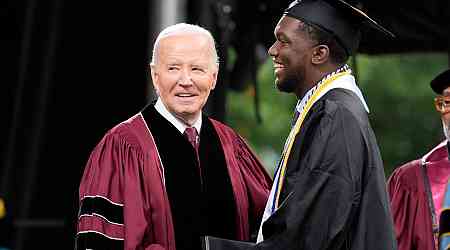It has become clear that one constituency — young voters, 18 to 29 years old — will play a key, if not pivotal, role in determining who will win the Biden-Trump rematch.
Four years ago, according to exit polls, voters in this age group kept Trump from winning re-election. They cast ballots decisively supporting Biden, 60-36, helping to give him a 4.46-point victory among all voters, 51.31 to 46.85 percent.
This year, Biden cannot count on winning Gen Z by such a large margin. There is substantial variance in poll data reported for the youth vote, but, to take one example, the NBC News national survey from April found Trump leading 43-42.
Young voters’ loyalty to the Democratic Party has been frayed by two distinct factors: opposition to the intensity of the Israeli attack on Hamas in Gaza and frustration with an economy many see as stacked against them.
Equally important, a large gender gap has emerged, with young men far less likely to support Biden than young women.
Bill McInturff, co-founder of the Republican polling firm Public Opinion Strategies — which conducts surveys for NBC along with the Democratic firm Hart Research — provided The Times with data covering a broad range of recent political and demographic trends.
Tracking the partisan identification and ideology of 18 to 34 year olds, the McInturff analyses show that from 2012 to 2023, women became increasingly Democratic, going from 55-29 in 2012 to 60-22 in 2023. The shift was even more striking in the case of ideology, going from 32 percent liberal and 29 percent conservative to 51 percent liberal and 17 percent conservative in 2023.
Among young men, the Democratic advantage in partisan identification fell from 9 points in 2012 to 5 points in 2023.
What gives?
I asked the Democratic pollster Celinda Lake, who recently joined the Biden campaign’s 2024 polling team, a job she also held in 2020. She sent a detailed reply by email:
Three reasons. First and foremost is the abortion issue and all the aspects of reproductive health including medication abortion, IVF, birth control and criminalizing abortion. Young men are very pro-abortion and birth control, but young women really vote the issue.
Second is style and respect. Young men are not as troubled by the chaotic and divisive style of Trump, while young women want people to be respected including themselves, want stability, and are very concerned about division and the potential for violence. Young women think Trump’s style is an embarrassment abroad, a poor role model for their children, and dangerous for the country. Younger men especially blue collar have a grudging respect for his strength and “tell it like it is” attitude.
Third is the economy. Young men, especially blue collar and people-of-color, feel left behind in this economy. They do not feel things have been delivered to them. They do not know anything about what this administration has done. Younger women are much more committed to a role for government to help people like themselves as a foundational view. They don’t know much more about the economic programs than young men but they tend to respond more favorably to Democrats in general on the economy. Younger men also feel more left behind on the economy and more sense of grievance than young women do who are also increasingly dominating college and higher education.
The Times Siena Poll conducted April 7-11 asked voters “How much do you think Donald Trump respects women?” A majority of men, at 54 percent, replied that Trump does respect women (23 percent “a lot” and 31 percent “some”), while 42 percent said he does not (14 percent “not much” and 28 percent “not at all”).
Women replied quite differently: 68 percent said Trump does not respect women (24 percent “not much,” 44 percent “not at all”), while 31 percent of women said Trump does respect women (15 percent “a lot” and 16 percent “some”).
Jean Twenge, a professor of psychology at San Diego State University and the author of “Generations: The Real Differences between Gen Z, Millennials, Gen X, Boomers and Silents and What They Mean for America’s Future,” wrote by email that the question of why there is such a gender divide “is tough to answer,” but she made some suggestions: “It could be that the changes on the left have driven young men away from the Democratic Party. For example, the idea that identities can be divided into “oppressor” and “oppressed” may have alienated some young men.”
Another likely factor, according to Twenge, is that
Fewer young men get college degrees than young women, and in the last 10-15 years the parties have split by education, with more of those without a college degree conservative and Republican. This appears even among high school seniors, where young men who do not plan to attend a 4-year college are 30 percent more likely to identify as conservative than young men who are planning to get a college degree.
Richard Reeves, who wrote the book “Of Boys and Men: Why the Modern Male Is Struggling, Why It Matters and What to Do about It,” argued in a January essay posted on his Substack that
In the centrifugal dynamic of culture-war politics, the more the right goes to one extreme, the more the left must go to the other, and vice versa. The left dismisses biology, the right leans too heavily on it. The left see a war on girls and women; the right see a war on boys and men. The left pathologizes masculinity; the right pathologizes feminism.
In this context, Reeves wrote, “Young men see feminism as having metastasized from a movement for equality for women into a movement against men, or at least against masculinity.”
In an article published in January on the Business Insider website, “The War Within Gen Z,” Daniel A. Cox, director of the Survey Center on American Life at the American Enterprise Institute, wrote:
Something strange is happening between Gen Z men and women. Over the past decade, poll after poll has found that young people are growing more and more divided by gender on a host of political issues. Since 2014, women between the ages of 18 and 29 have steadily become more liberal each year, while young men have not. Today, female Gen Zers are more likely than their male counterparts to vote, care more about political issues and participate in social movements and protests.
Cox noted that “at no time in the past quarter century has there been such a rapid divergence between the views of young men and women,” suggesting that “something more significant is going on than just new demographic patterns, such as rising rates of education or declining adherence to a religion — the change points to some kind of cataclysmal event.”
After interviewing young voters, Cox and his colleagues at the A.E.I. survey center concluded:
Among women, no event was more influential to their political development than the #MeToo movement. In 2017, women around the world began speaking out about their experiences with sexual assault and harassment. Gen Zers were then in high school and college, and for them, the movement came at a formative moment.
But, Cox continued,
While women were rallying together, many Gen Z men began to feel like society was turning against them. As recently as 2019, less than one-third of young men said that they faced discrimination, according to Pew, but today, close to half of young men believe they face at least some discrimination. In a 2020 survey by the research organization P.R.R.I, half of men agreed with the statement: “These days society seems to punish men just for acting like men.”
For a growing percentage of young men, Cox wrote,
Feminism has less to do with promoting gender equality and more to do with simply attacking men. A 2022 survey by the Southern Poverty Law Center found that 46 percent of Democratic men under 50 agreed that feminism has done more harm than good and even more Republican men agreed.
More young men, he added, “are adopting a zero-sum view of gender equality — if women gain, men will inevitably lose.”
How does this translate into politics?
According to Cox:
While women have turned to the left for answers to their problems, men are finding support on the right. Trump helped redefine conservatism as a distinctly masculine ideology, stoking grievances and directing young men’s frustration toward liberals and feminists. There are signs the message is resonating: Republican affiliation among white men aged 18 to 24 jumped from 28 percent in 2019 to 41 percent in 2023, according to a Harvard Youth Poll.
On April 8, McInturff published a report on his firm’s website, “Key Data by Generation.”
“We are witnessing a profound generational break,” he writes, “between Generation Z versus the baby boomers that is already reshaping our country, its values, media habits and its politics.”
At the outset, McInturff compares the values of Gen Z respondents between the ages of 18 and 26 with those of the Baby Boom, now 59 to 77.
Some 76 percent of baby boomers place a high value on patriotism; for Gen Z patriotism, it is a meh 32 percent. Nearly two thirds of baby boomers, 65 percent, highly value religion and their belief in God; Gen Z, 26 percent. Having kids: baby boomers, 52 percent, Gen Z, 23 percent. Asked if they agree that “America is the best place to live,” 66 percent of boomers said yes, double the 33 percent of 18 to 26 year olds.
In other words, the youngest voters are, at least for the moment, disaffected from traditional notions of family, country and religion.
Even so, young voters as a whole are decidedly more liberal on specific policies and issues than their elders.
On gay marriage, according to McInturff’s data, 84 percent of voters 18 to 34 are in favor, compared with 51 percent of voters 65 and over. End transgender discrimination: young 55 percent, old 24 percent. Climate change: 64 to 39. Cut the defense budget, 48 to 24.
One particular issue is currently working against Biden and Democrats among young voters.
“The Israel/Hamas war in Gaza reflects one of the sharpest policy differences by age we have seen over a 40-year period,” McInturff writes. “President Biden’s support for Israel has collapsed his standing with one of his key and previously most supportive subgroups, 18-to-29-year-old voters.”
McInturff compared data on voters 18 to 34, in two categories: surveys conducted between January and September 2023 ,before the war began, and surveys conducted after it started, between November 2023 and January 2024.
The shift among these young voters is terrible news for the Biden campaign. In the pre-Gaza polling, young voters backed Biden by 29 points, 61-32. In the post-Gaza surveys, Biden’s advantage over Trump fell to four points, 45-41.
If the decline in young peoples’ support for Democrats holds true through Election Day, it will be a major setback for Democratic strategists who, before the outbreak of the Israeli-Hamas war, were banking on what appeared to be a secure partisan commitment by Gen Z and Millennials to the Democratic Party.
One of the key findings in the Harvard Youth Poll of 2,010 18 to 29 year olds, conducted March 14-21, is that support for Biden among young voters fell far short of his support four years ago:
If the presidential election were held today, President Biden would outperform former President Trump among both registered (50 percent Biden, 37 percent Trump) and likely young voters under 30 (56 percent Biden, 37 percent Trump). When there is no voter screen (i.e., all young adults 18-29), the race narrows to single digits, 45 percent for President Biden, 37 percent for Trump, with 16 percent undecided.
At the same point in 2020, the Harvard Youth Poll “showed Biden leading Trump by 23 points among all young adults (51 percent-28 percent)” compared with an 8-point lead in 2024. Among “likely” young voters in 2020, Biden led Trump by 33 points (60 percent-27 percent) compared with 19 points in the current survey.
Young men account for virtually all the drop in support for Biden.
Joe Biden leads among both men (+6) and women (+33). Compared with this stage in the 2020 campaign, Biden’s lead among women is nearly identical (was +35 in 2020), but his lead among likely male voters has been dramatically reduced from +26 in 2020 to +6 today.
The same pattern emerged in partisan identification:
In 2020, 42 percent of young men in our poll identified as Democrats and 20 percent were Republicans (+22 Democratic advantage); in this wave, 32 percent are Democrats and 29 percent are Republicans (+3 Democratic advantage).
Over the same period, the Democratic advantage among women expanded by six points. In 2020, 43 percent of young women in our poll identified as Democrats, and 23 percent were Republicans (+20 Democratic advantage); in this wave, 44 percent are Democrats, and 18 percent are Republicans (+26 Democratic advantage).
The Harvard survey corroborates McInturff’s analysis of the damage inflicted on the Biden campaign by the Israeli-Hamas war. The Harvard study found that anger over the conflict has produced a substantial bloc of young voters — although not a majority — opposed to Israel’s attacks in Gaza.
The Harvard Youth Survey found that when asked if the Oct. 7 attack on Israel by Hamas justified Israel’s continuing response, “a plurality indicates that they don’t know (45 percent). About a fifth (21 percent) report that Israel’s response was justified, with 32 percent believing it was not justified.”
According to the Harvard survey, “Young Americans support a permanent cease-fire in Gaza by a five-to-one margin (51 percent support, 10 percent oppose). No major subgroup of young voters opposes such action.”
If Biden is struggling to restore his majorities among young voters, how is it that he remains competitive with Trump, running behind by 1.4 percentage points, according to the RealClearPolitics average of recent polls?
One reason is that the share of the electorate made up of the white working class, the core of Trump’s support, is steadily declining, while the number of college-educated whites, an increasingly strong source of Democratic support, is growing.
A second factor is that defections to the Republican Party that had been emerging among a small percentage of Black and Hispanic voters appear to have stopped, if not reversed. Matthew Blackwell, a political scientist at Harvard who tracks polling trends, posted graphics on X this month, noting, “Biden mildly trending better among Black and Hispanic subgroups in the last few weeks of polling.”
In an email, Blackwell expanded on his post: “The big takeaways are that Biden has been polling worse with Black and Latino voters compared to 2016 and 2020, but over the course of April, we did see some movement of these groups back to the 2020 levels, even if they haven’t quite gotten there yet.”
Blackwell predicted that “we can probably expect many prior Biden voters to ‘return to the fold’ as the campaign goes on,” before adding that many surveys may underestimate support for Biden:
Most of the polls are of registered voters without likely-voter screens. Many pollsters have found that regular voters are more supportive of Biden than nonregular voters. As we get closer to Election Day, we will probably see more likely-voter polls that may be more accurate.
Biden has actually improved on his 2020 margins with several very large blocs of voters: whites with college degrees (plus 1.3 points), whites without degrees (plus 0.6 points), 50 to 64 year olds (plus 4 points), and voters 65 and older (plus 1.8 points). While the percentages are small, the groups are huge, making even a half a percentage point shift significant.
The closeness of the contest between Trump and Biden puts especially heavy pressure on Biden to negotiate a cease-fire, if not a conclusion to hostilities in Gaza. Nothing would do more to restore at least some of the crucial support he received from young men and women four years ago.
Thomas B. Edsall has been a contributor to The New York Times Opinion section since 2011. His column on strategic and demographic trends in American politics appears every Wednesday. He previously covered politics for The Washington Post. This article originally appeared in The New York Times.
function onSignUp() { const token = grecaptcha.getResponse(); if (!token) { alert("Please verify the reCAPTCHA!"); } else { axios .post( "https://8c0ug47jei.execute-api.us-east-1.amazonaws.com/dev/newsletter/checkCaptcha", { token, env: "PROD", } ) .then(({ data: { message } }) => { console.log(message); if (message === "Human



























